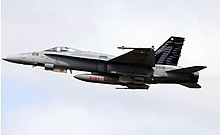Quick Reaction Alert
Quick Reaction Alert (QRA) describes a level of combat readiness in military aviation .
meaning

The term “QRA” is used uniformly in all NATO countries, but also non-NATO countries like Switzerland use this term. Some states use different terms, but the system is the same. Nowadays the term “QRA” is used exclusively for the alertness of aircraft for air defense (interceptors) or the air police service . This has grown in importance since the September 11, 2001 attacks. During the Cold War , the nuclear armed air forces also had nuclear-armed carrier aircraft (both tactical fighter-bombers and strategic bombers) under QRA readiness. After the alarm has been triggered, the alarm riot must be in the air within a specified time (e.g. 15 minutes). Depending on the alarm situation, these times can be shortened to 10 or 5 minutes. At 10 minutes the pilots are already in the cockpit, at 5 minutes the machines are ready to take off on the runway. The next higher level is combat air patrol . Which QRA level (QRA 15, QRA10, ...) is set depends on the threat situation and on the information available on expected incidents in the airspace.
history
During the Cold War , military units that were in “Quick Reaction Alert” were supposed to react immediately to a surprise attack by the Warsaw Pact , or in the interests of a balance of horror, prevent such an attack. A comparable combat readiness system existed on the part of the Warsaw Pact and the nuclear forces of the Soviet Union. In the air force of the National People's Army of the GDR , this readiness was called the "Duty System" (DHS).
The air force squadrons equipped with nuclear weapons in Western Europe had two nuclear-armed aircraft each that were ready to take off within 30 minutes. Contingents of medium-range nuclear missiles ( Pershing IA and Pershing II ) and cruise missiles had to be ready to fire within 15 minutes.
As early as 1986, NATO significantly reduced the alertness of its nuclear weapons systems: On the one hand, a surprise attack by the Warsaw Pact was considered unrealistic, on the other hand, nuclear weapons should only be used after an agreement within NATO, which would have entailed a corresponding delay.
See also
literature
- NATO changes alarm plan for nuclear units . In: Mediatus . No. 11/86 . Research Institute for Peace Policy, Starnberg 1986.
Web links
Individual evidence
- ↑ Order from the SiK-S meeting on April 19, 2011: Air police service guarantee ( Memento of the original from August 5, 2012 in the Internet Archive ) Info: The archive link was automatically inserted and not yet checked. Please check the original and archive link according to the instructions and then remove this notice.
- ↑ Report on expansion 24h standby in 20min online
- ↑ Presentation of the construction of the air police service 24 hours a day